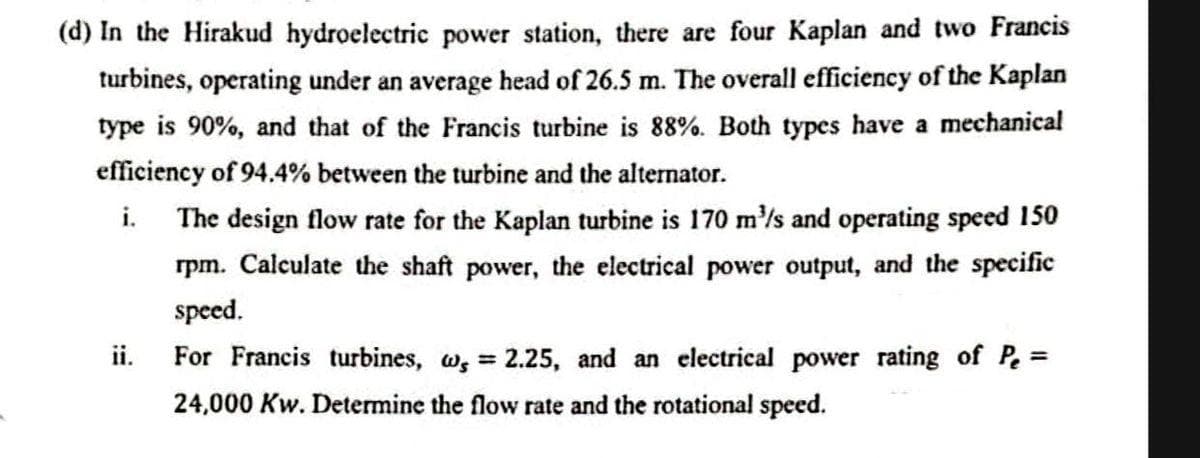(d) In the Hirakud hydroelectric power station, there are four Kaplan and two Francis turbines, operating under an average head of 26.5 m. The overall efficiency of the Kaplan type is 90%, and that of the Francis turbine is 88%. Both types have a mechanical efficiency of 94.4% between the turbine and the alternator. i. The design flow rate for the Kaplan turbine is 170 m'/s and operating speed 150 rpm. Calculate the shaft power, the electrical power output, and the specific speed. ii. For Francis turbines, w, 2.25, and an electrical power rating of Pe = %3D 24,000 Kw. Determine the flow rate and the rotational speed.
(d) In the Hirakud hydroelectric power station, there are four Kaplan and two Francis turbines, operating under an average head of 26.5 m. The overall efficiency of the Kaplan type is 90%, and that of the Francis turbine is 88%. Both types have a mechanical efficiency of 94.4% between the turbine and the alternator. i. The design flow rate for the Kaplan turbine is 170 m'/s and operating speed 150 rpm. Calculate the shaft power, the electrical power output, and the specific speed. ii. For Francis turbines, w, 2.25, and an electrical power rating of Pe = %3D 24,000 Kw. Determine the flow rate and the rotational speed.
Elements Of Electromagnetics
7th Edition
ISBN:9780190698614
Author:Sadiku, Matthew N. O.
Publisher:Sadiku, Matthew N. O.
ChapterMA: Math Assessment
Section: Chapter Questions
Problem 1.1MA
Related questions
Question

Transcribed Image Text:(d) In the Hirakud hydroelectric power station, there are four Kaplan and two Francis
turbines, operating under an average head of 26.5 m. The overall efficiency of the Kaplan
type is 90%, and that of the Francis turbine is 88%. Both types have a mechanical
efficiency of 94.4% between the turbine and the alternator.
i. The design flow rate for the Kaplan turbine is 170 m'/s and operating speed 150
rpm. Calculate the shaft power, the electrical power output, and the specific
speed.
ii.
For Francis turbines, w, = 2.25, and an electrical power rating of P =
24,000 Kw. Determine the flow rate and the rotational speed.
Expert Solution
This question has been solved!
Explore an expertly crafted, step-by-step solution for a thorough understanding of key concepts.
Step by step
Solved in 3 steps

Knowledge Booster
Learn more about
Need a deep-dive on the concept behind this application? Look no further. Learn more about this topic, mechanical-engineering and related others by exploring similar questions and additional content below.Recommended textbooks for you

Elements Of Electromagnetics
Mechanical Engineering
ISBN:
9780190698614
Author:
Sadiku, Matthew N. O.
Publisher:
Oxford University Press

Mechanics of Materials (10th Edition)
Mechanical Engineering
ISBN:
9780134319650
Author:
Russell C. Hibbeler
Publisher:
PEARSON

Thermodynamics: An Engineering Approach
Mechanical Engineering
ISBN:
9781259822674
Author:
Yunus A. Cengel Dr., Michael A. Boles
Publisher:
McGraw-Hill Education

Elements Of Electromagnetics
Mechanical Engineering
ISBN:
9780190698614
Author:
Sadiku, Matthew N. O.
Publisher:
Oxford University Press

Mechanics of Materials (10th Edition)
Mechanical Engineering
ISBN:
9780134319650
Author:
Russell C. Hibbeler
Publisher:
PEARSON

Thermodynamics: An Engineering Approach
Mechanical Engineering
ISBN:
9781259822674
Author:
Yunus A. Cengel Dr., Michael A. Boles
Publisher:
McGraw-Hill Education

Control Systems Engineering
Mechanical Engineering
ISBN:
9781118170519
Author:
Norman S. Nise
Publisher:
WILEY

Mechanics of Materials (MindTap Course List)
Mechanical Engineering
ISBN:
9781337093347
Author:
Barry J. Goodno, James M. Gere
Publisher:
Cengage Learning

Engineering Mechanics: Statics
Mechanical Engineering
ISBN:
9781118807330
Author:
James L. Meriam, L. G. Kraige, J. N. Bolton
Publisher:
WILEY